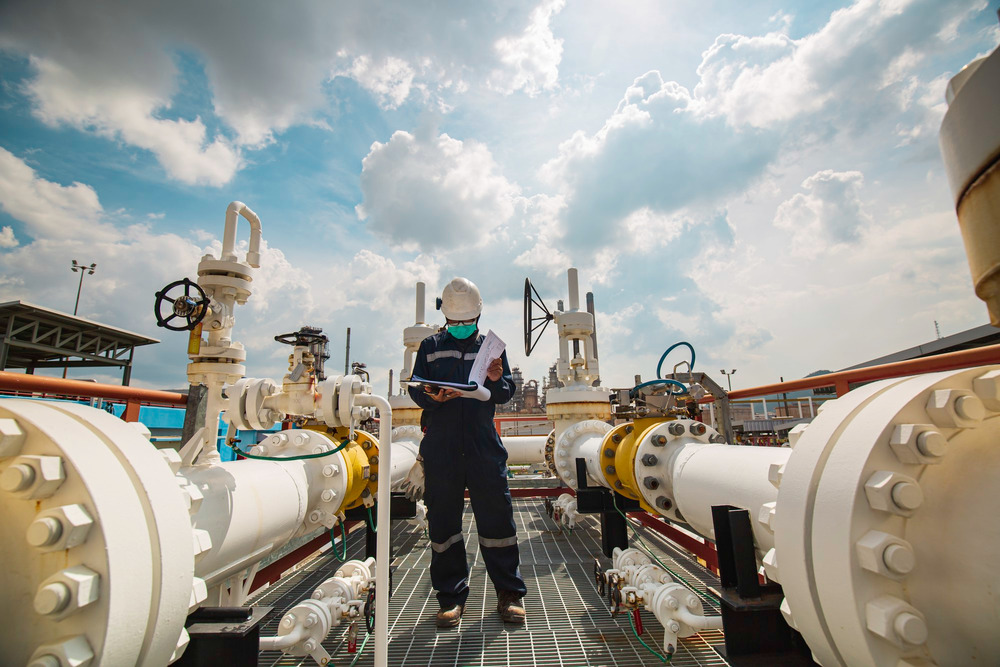What is Industry 4.0? What are Industry 4.0 Innovations?
In the era of rapid technological advancement, Industry 4.0 represents the next stage of industrial transformation, integrating smart technologies, automation,...
Devamını Oku

Sustainable management of energy resources has become a strategic priority in today’s global landscape. In this context, underground gas storage systems play a pivotal role in ensuring energy supply security. These systems are essential for maintaining a steady and balanced flow of natural gas to end users. During periods of high energy demand—such as winter seasons or emergency situations—storage solutions are activated to maintain supply-demand equilibrium. Ensuring uninterrupted energy supply is not only an economic necessity but also a matter of national security.
Gas storage also provides critical advantages in managing volatility within energy markets. It helps stabilize prices, absorb seasonal fluctuations, and introduce flexibility into energy production. With technological advancements, modern gas storage systems are now safer, more efficient, and environmentally sustainable. These systems benefit both suppliers and consumers, serving as a strategic tool in effective energy management. In future energy strategies, underground storage will continue to play a major role in reducing environmental impacts and supporting energy independence.
Gas storage refers to the process of holding natural gas in dedicated facilities for future use, ensuring a consistent and reliable energy supply. It is a strategic approach to balancing the gap between production and consumption, particularly during periods of fluctuating demand. Natural gas consumption is typically higher in winter, while production can remain steady throughout the year. To meet peak demands, excess gas is stored during low-consumption periods and withdrawn when needed. This not only stabilizes supply chains but also strengthens national energy security and supports long-term planning in the energy sector.
Storage systems are vital in responding to emergencies, market disruptions, and sudden changes in demand. By reducing reliance on real-time supply, they help prevent shortages and price spikes. In modern energy infrastructure, gas storage enables operational flexibility for power plants, industries, and distribution networks. It also plays a role in price arbitrage, allowing operators to buy gas at low prices and store it until the market conditions are favorable. Ultimately, gas storage ensures the availability of energy when it’s most needed, acting as a buffer that supports grid stability, economic performance, and environmental responsibility.
Modern gas storage systems are engineered infrastructures designed to hold natural gas safely and efficiently until it is needed. These systems help bridge the gap between continuous gas production and variable consumer demand. There are several types of storage facilities, including depleted gas reservoirs, salt caverns, aquifers, and above-ground LNG (liquefied natural gas) tanks. Each system type is selected based on geographic, geological, and operational considerations. For instance, depleted fields are often reused because of their proven sealing integrity and existing infrastructure. Salt caverns offer high deliverability rates, making them ideal for short-term, high-demand periods.
Gas storage systems must be designed to meet stringent technical requirements such as pressure resistance, gas tightness, and long-term durability. These systems also incorporate advanced monitoring and automation technologies to ensure safety and operational efficiency. Real-time data tracking enables operators to respond swiftly to any anomalies, reducing downtime and minimizing risk. Efficient storage systems enhance energy grid stability and support emergency preparedness. They also help optimize market strategies by allowing suppliers to store gas when prices are low and release it during high demand. As energy needs evolve, these systems will remain critical to maintaining a resilient and balanced energy infrastructure.
Underground gas storage is one of the most effective and large-scale solutions for maintaining a stable and secure natural gas supply. These systems utilize naturally occurring geological formations such as depleted gas fields, salt domes, and aquifers to store vast volumes of gas. By repurposing these underground spaces, operators can minimize environmental disruption while taking advantage of natural pressure retention capabilities. This method allows for high-capacity, long-term storage that can support regional or national energy demands during peak consumption seasons or unexpected supply disruptions. The adaptability and scale of these systems make them essential assets in any comprehensive energy strategy.
Developing underground storage requires extensive geological surveys, advanced engineering, and robust safety protocols. The integrity of the rock formations must be carefully assessed to ensure containment over extended periods. Modern facilities are equipped with automated monitoring tools, allowing operators to track pressure, temperature, and gas flow in real-time. This increases system responsiveness and reduces operational risks. Underground solutions are also strategically located to serve urban, industrial, or power generation hubs efficiently. Despite high initial investment costs, the long-term benefits of energy security, price stability, and system flexibility make underground gas storage a critical infrastructure investment for the future.
Efficiency in gas storage systems is crucial to reducing operational costs, improving energy delivery, and maximizing the value of stored resources. A highly efficient system ensures that gas can be injected and withdrawn quickly, safely, and with minimal loss. This is achieved through smart design, regular maintenance, and integration of automation technologies. For example, real-time monitoring tools help detect leaks, optimize pressure levels, and schedule maintenance without interrupting operations. These capabilities extend the lifespan of the infrastructure while ensuring consistent performance. Energy providers can respond faster to market demands, leading to better service reliability and customer satisfaction.
Operational efficiency also contributes to environmental sustainability by minimizing gas leakage and energy waste. Efficient systems consume less energy during injection and withdrawal cycles, which lowers emissions and reduces the environmental footprint of storage operations. Additionally, well-managed facilities improve profitability by supporting strategic gas trading based on market pricing. As demand for cleaner energy grows, optimizing storage operations becomes even more vital. Through automation, data analytics, and predictive maintenance, operators can enhance performance while reducing risk. Investing in the efficiency of gas storage operations ultimately strengthens energy resilience and supports the transition to a more sustainable energy future.
As the energy industry evolves, the development of innovative gas storage systems is becoming increasingly vital to meet emerging challenges. Future technologies will focus on automation, sustainability, and integration with renewable energy sources. Smart systems equipped with IoT sensors and AI-based analytics will enable predictive maintenance, real-time monitoring, and dynamic flow control. These capabilities will enhance safety, reduce operational costs, and optimize performance. Additionally, digital twins and simulation tools will allow operators to test various scenarios before implementation, improving strategic planning. As grid flexibility and reliability become priorities, next-generation storage systems will be key to balancing intermittent renewable energy sources like wind and solar.
Emerging technologies also include hybrid storage models that combine natural gas with hydrogen or biogas, offering cleaner alternatives and lower emissions. Materials science advancements may lead to the development of more efficient insulation and containment systems, further minimizing energy loss. Subsurface mapping innovations will improve site selection and boost the safety of underground installations. Moreover, modular and scalable systems will allow for faster deployment and better adaptation to local energy needs. As climate goals push industries toward decarbonization, the future of gas storage will center around sustainability, resilience, and digital transformation. Investing in these technologies today will lay the foundation for tomorrow’s secure and efficient energy systems.

In the era of rapid technological advancement, Industry 4.0 represents the next stage of industrial transformation, integrating smart technologies, automation,...
Devamını Oku
Fire detection systems are vital safety solutions that help detect signs of fire at an early stage in buildings and...
Devamını Oku
Communication infrastructure forms the foundation of modern digital systems, enabling the seamless and secure transfer of information across various platforms....
Devamını OkuPROTECTION OF PERSONAL DATA
WEBSITE COOKIE POLICY
Your personal data; It is one of the leading principles of our Organization to protect the privacy of visitors to the website (www.adatech.com.tr) operated by ADATECH as the data controller. This Cookie Usage Policy (“Policy”) explains to all our website visitors and users which types of cookies are used and under what conditions.
Cookies are small text files stored on your device or network server by websites you visit on your computer or mobile device.
They are generally used to provide you with a personalized experience during your use of the website you visit, to improve the services offered and to improve your experience, and may contribute to ease of use while browsing a website. If you do not prefer the use of Cookies, you can delete or block Cookies in your browser settings. However, we would like to remind you that this may affect your use of our website. Unless you change your cookie settings in your browser, we will assume that you accept the use of cookies on this website.
1. WHAT KIND OF DATA IS PROCESSED IN COOKIES?
Cookies on websites, depending on their type, collect data about your browsing and usage preferences on the device you visit the site. This data includes information about the pages you access, the services and products you review, your preferred language option and other preferences.
2. WHAT is a solution and what are its intended uses?
Cookies are small text files that are stored on your device or network server through browsers by websites you visit. These small text files, which contain your preferred language and other settings on the site, help us remember your preferences the next time you visit the site and make improvements to our services to improve your experience on the site. Thus, you can have a better and personalized usage experience on your next visit.
The main purposes of using cookies on our Website are listed below:
3.TYPES OF COOKIES USED ON OUR WEBSITE
3.1. Oturum Çerezleri
Session cookies ensure that the website functions properly during your visit. They are used for purposes such as ensuring the security and continuity of our sites and you during your visit. Session cookies are temporary cookies, they are deleted when you close your browser and come to our site again, they are not permanent.
3.2. Persistent Cookies
These types of cookies are used to remember your preferences and are stored on your device via browsers. Persistent cookies remain stored even after you close your browser or restart your computer from which you visited our site. These cookies are kept in subfolders of your browser until they are deleted through your browser’s settings.
Some types of persistent cookies may be used to provide you with special suggestions, taking into account issues such as your purpose of using the Website.
Thanks to persistent cookies, if you visit our Website again with the same device, it is checked whether there is a cookie created by our Website on your device and if there is, it is understood that you have visited the site before and the content to be transmitted to you is determined accordingly and thus a better service is provided to you.
3.3. Mandatory/Technical Cookies
These cookies are essential for the website you visit to function properly. The purpose of such cookies is to provide necessary services by enabling the website to function. For example, it allows you to access secure parts of the website, to use its features, to navigate on it.
3.4. Analytical Cookies
They collect information about the way the website is used, the frequency and number of visits, and show how visitors navigate to the site. The purpose of using such cookies is to increase performance by improving the way the site functions and to determine the general trend direction. They do not contain data that could enable the identification of visitors. For example, they show the number of error messages displayed or the most visited pages.
3.5. Functional/Functional Cookies
It saves the choices made by the visitor within the site and remembers them on the next visit. The purpose of such cookies is to provide ease of use to visitors. For example, it prevents the site user from re-entering the user password on each page they visit.
3.6. Targeting/Advertising Cookies
They enable the measurement of the effectiveness of advertisements served to visitors and the calculation of the number of times the advertisements are viewed. The purpose of such cookies is to serve ads customized to the interests of visitors.
Likewise, they enable the detection of visitors’ interests specific to their browsing and the presentation of appropriate content. For example, it prevents the advertisement shown to the visitor from being shown again in a short time.
4. HOW TO MANAGE COOKIE PREFERENCES?
To change your preferences regarding the use of cookies or to block or delete cookies, simply change your browser settings.
Many browsers give you the option to accept or reject cookies, accept only certain types of cookies, or be alerted by the browser when a website requests to store cookies on your device so that you can control cookies.
It is also possible to delete cookies previously saved in your browser.
If you disable or refuse cookies, you may need to set some preferences manually, some features and services on the website may not function properly as we will not be able to recognize and associate your account. You can change the settings of your browser by clicking on the relevant link from the table below.
5. ENFORCEMENT OF WEBSITE PRIVACY POLICY
Website Privacy Policy …./…./…./…. . is dated. In case all or certain articles of the Policy are renewed, the effective date of the Policy will be updated. The Privacy Policy is published on the website of the Authority (www.adatech.com.tr) and made available to the relevant persons upon the request of the personal data owners.
ADATECH
Address: Esenyalı Neighborhood Yanyol Street Varyap Plaza No:61-148 Pendik / Istanbul
Telephone: +90 (216 ) 514 80 69
E-mail: info@adatech.com.tr
Web Address: www.adatech.com.tr